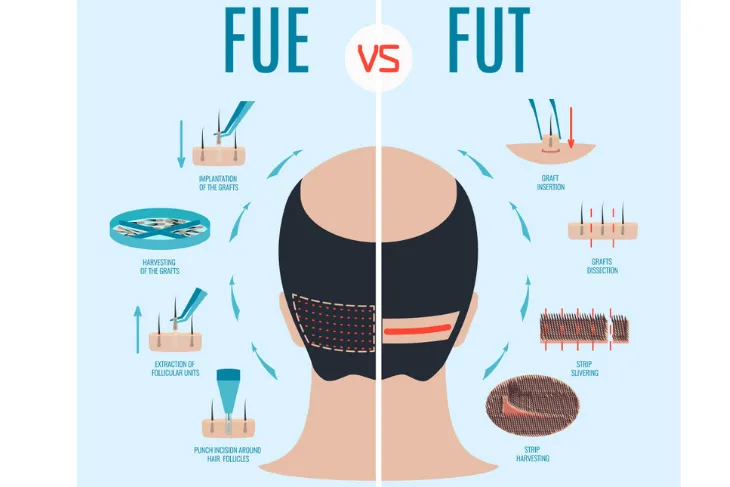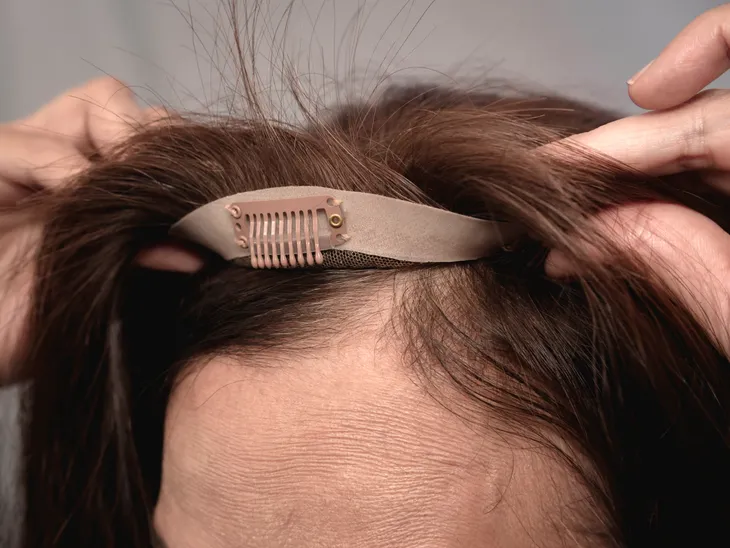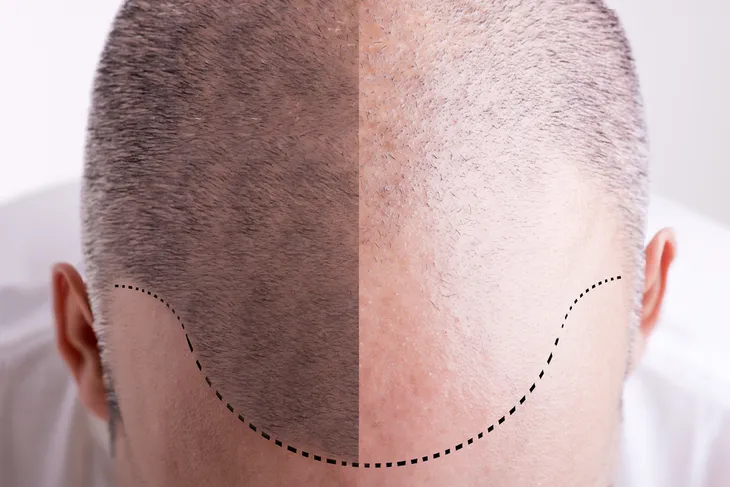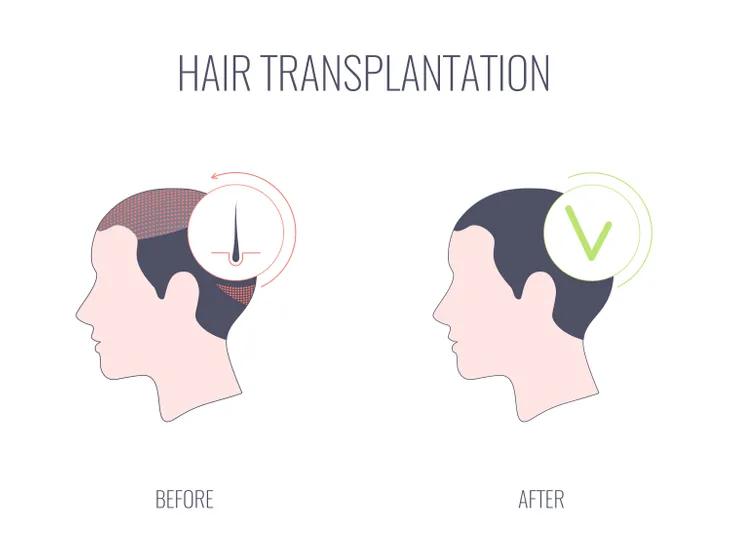Hair loss affects both men and women, but tends to occur more frequently in men. We all lose hair on a regular basis. The average person loses about 100 strands of hair a day. However, true hair loss occurs when someone suffers thinning or bald patches on their scalp. This hair loss can be temporary or it can be permanent, says the Mayo Clinic. It’s often heredity, but can also be the result of hormonal changes, medical conditions, or just normal aging.
When treating hair loss, it all comes down to personal preference. Some people decide to let it run its course, while others might try to cover it up. This can be done with hair styles or treatments that prevent further hair loss or help restore growth.
For the sake of this article, we’re going to explore both surgical and non-surgical hair replacement and the pros and cons of each…
What is Surgical Hair Replacement?
The most common surgical hair replacement procedure is a surgical hair transplant. It involves removing healthy hair follicles from one part of the body to another area that is bald or balding.
There are two main techniques — the first is follicular unit transplantation (FUT) and the second is follicular unit extraction (FUE), explains Hairclub.
What is Non-Surgical Hair Replacement?
Non-surgical hair replacement encompasses a wide variety of options including medications, supplements, procedures, and products. These are either treatments that can be worn to replace hair that has fallen out or encourage regrowth. What they all have in common is that they do not require any form of surgery.
One of the most common forms of non-surgical hair replacement is wigs or toupees. There is also scalp micropigmentation (SMP), a non-surgical procedure that uses small, tattooed dots to create the appearance of hair. This is for people who are experiencing thinning as it doesn’t replace the hair, but rather replicates the look of fuller hair, explains forhims.com.
Lastly, there are some FDA-approved medications available such as Finasteride and Minoxidil. The first is an oral medication that works by blocking DHT (the hormone that causes male pattern baldness). Minoxidil is a topical medication that can be applied directly to the scalp and help increase hair growth, explains the source.
Surgical Hair Replacement
Pro: Surgical Hair Replacement Looks Natural and is Permanent
Hair loss or baldness can really affect a person’s self esteem. While there are many reasons to go the non-surgical route, when it comes to confidence, surgical hair replacement will provide the biggest boost. This is because surgical hair replacement is the most natural and permanent option.
With a more permanent option like a surgical hair transplant, there’s no fear of losing a wig or toupee while swimming or exercising. Once the procedure is over and recovery is complete, the patient can go about living their life. There’s no regular maintenance or upkeep and the results last a lifetime. Since the donor is usually the recipient, the hair looks completely natural.
Con: Surgical Hair Replacement is Costly
The cost associated with hair transplant surgery varies depending on the doctor and clinic where the surgery is performed. According to Hairbro, the cost per procedure can be up to $15,000 USD. Since it is an elective cosmetic surgery, hair transplants are often not covered by medical insurance.
Pro: Surgical Hair Replacement Promotes the Growth of Natural Hair
According to Arizona Dermatology, hair transplants work with healthy hair follicles which means they retain their “genetic resistance to the effects of dihydrotestosterone, an active form of testosterone in the body’s tissues.” Thanks to this, once the hair is transplanted, it’ll continue to grow and won’t be susceptible to hair loss.
Because the hair that is implanted continues to grow for its entire lifecycle, there’s typically no follow up treatment or maintenance needed.
Con: Surgical Hair Replacement Can Lead to Infection
Just like with any surgical procedure, there are some risks involved. Hair transplants do carry the risk of infection or hemorrhaging. While the chances of this happening are relatively low, there is still a risk.
The best way for patients to avoid this is to follow the strict instructions and guidelines of their doctor. If they are able to do so, the risk of infection is highly unlikely. Hairbro explains that if an infection or bleeding does occur, they are often quite treatable.
Pro: No Specialized Treatment or Maintenance Needed
Unlike with non-surgical hair transplant procedures that require consumers to continue buying or replacing products, there’s no maintenance after a hair transplant surgery. The hair that was implanted will continue to grow for its entire lifecycle. Again, most of the time, the donor is also the recipient, so the hair also looks completely natural.
Con: Hair Loss May Continue After Surgical Hair Replacement
Even though hair transplant surgery results in the regrowth of natural hair, continued hair loss is still a risk. The risk is very low, says Hairbro, but in some cases the transplanted hair will fall out with no signs of regrowth.
The source notes that most of the time when this happens it’s just a “shedding of hairs” and will grow back after a short period of time.
Con: Surgical Hair Replacement Has a Long Recovery
In addition to being more invasive, hair transplant surgery has a long recovery time. This recovery period isn’t painful, but rather might test the patient’s patience! Hairbro explains that newly transplanted hair needs three to five months to grow again.
There may be even more additional time in order to get the hair to the same length as the rest of their hair. As a result, it can take anywhere from 8 to 12 months after the procedure for the patient to get their desired results.
Non-Surgical Hair Replacement
Pro: Non-Surgical Hair Replacement is Non-Invasive
Unlike surgical options which do require patients to be put under a local anesthesia for the procedure, the non-surgical hair replacement options are non-invasive. Therefore, they are relatively safer. In addition to the cost of surgery, many people are put off by the idea of undergoing surgery for their hair loss.
Non-surgical hair replacement options do not carry the risk of infection, scarring, or any anesthetic dangers, so they tend to be the more appealing option.
Con: Non-Surgical Hair Replacement Isn’t as Natural
While there are many great products available on the market, most of which have definitely improved over time, there’s no denying that a surgical transplant of real hair is more natural looking than a wig or scalp micropigmentation. It all depends on how much a person is willing to spend. According to forhims.com, hair systems can vary greatly in their quality.
Pro: Non-Surgical Hair Replacement is More Cost-Friendly
As with any surgery, a surgical hair transplant can cost as much as $15,000, says Hairbro. Since it’s cosmetic, it’s often not covered by medical insurance. Most people do not have the funds to pay for a procedure like this which is another reason non-surgical options are much more appealing.
While there is the cost of maintenance and upkeep, it’s still cheaper than having to pay a large sum of money up front. Plus, there’s always the risk that the patient isn’t happy with their results and will have to continue paying in order to get the desired results.
Con: Non-Surgical Hair Replacement Requires Upkeep
Hairbro explains that because the non-surgical hair replacement options don’t attach directly to the scalp, the skin beneath will still shed and produce body oils. As a result, there is more maintenance and upkeep involved. To maintain a natural look, consumers need to stay on top of repairs, as well as regular cleaning and washing.
However, even with meticulous care, there is a shelf life on every hair system. Plus with products like medications and supplements, there is repeat buying involved. While the up front cost is less, over time it could end up being just as expensive depending on the product and how often it needs to be replaced.
Pro: Non-Surgical Hair Replacement Has Immediate Results
You’d think that the surgical option would have more immediate results, but that’s not the case! When a person undergoes hair transplant surgery, their hair will continue to look the same for about a month as it can take several months for newly transplanted hair to grow.
Non-surgical hair replacement options have immediate results. Place the product on your head and immediately see what it looks like! It’s also more customizable, particularly when it comes to wigs and toupees. There’s no waiting period to find out if the procedure worked or waiting for hair to grow. If you don’t like how it looks, it can easily be changed.

















